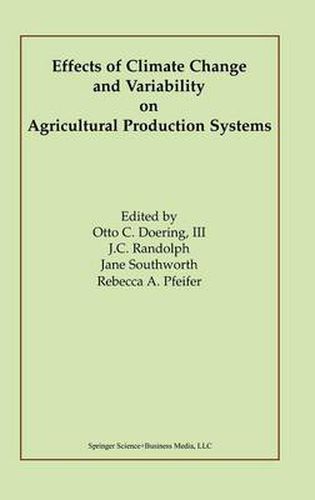Readings Newsletter
Become a Readings Member to make your shopping experience even easier.
Sign in or sign up for free!
You’re not far away from qualifying for FREE standard shipping within Australia
You’ve qualified for FREE standard shipping within Australia
The cart is loading…






This title is printed to order. This book may have been self-published. If so, we cannot guarantee the quality of the content. In the main most books will have gone through the editing process however some may not. We therefore suggest that you be aware of this before ordering this book. If in doubt check either the author or publisher’s details as we are unable to accept any returns unless they are faulty. Please contact us if you have any questions.
Evidence shows that global climate change is occurring. Research and debate continue on the role of increasing atmospheric concentrations of greenhouse gases in influencing climate change. Many sectors are, or will be, influenced by changing climate and climate variability, including increasing global temperatures, changing precipitation patterns, and increased frequency of unusual weather events. Agriculture and the world’s supply of food and fibre are particularly vulnerable to such climate change. This text provides an integrated assessment of global climate change’s impact on agriculture at the farm level, in the context of farm level adaptation decisions. Ten agricultural areas in the Upper Midwest region - the heart of the United States’ corn belt - were subjected to climate change and changing climate variability scenarios through simulations of future climate using results from general circulation models. Crop growth models, calibrated to the study sites, were used to simulate yields under varying climate conditions. Farm level production and economic analyses were performed to determine what adaptation strategies might be best utilized to maintain production and profitability for producers under conditions of global climate change and changing climate variability. Similar integrated analyses from Australia and Argentina provide comparisons from different regions. The robust integrated systems methodology for assessing impacts and adaptation opportunities in several different major agricultural regions provides the reader with an example for similar endeavours. Also discussed are guidelines and useful analytical options for input suppliers, agricultural researchers, and agricultural producers to enable risk averting strategies and adaptations as global climate change plays out.
$9.00 standard shipping within Australia
FREE standard shipping within Australia for orders over $100.00
Express & International shipping calculated at checkout
This title is printed to order. This book may have been self-published. If so, we cannot guarantee the quality of the content. In the main most books will have gone through the editing process however some may not. We therefore suggest that you be aware of this before ordering this book. If in doubt check either the author or publisher’s details as we are unable to accept any returns unless they are faulty. Please contact us if you have any questions.
Evidence shows that global climate change is occurring. Research and debate continue on the role of increasing atmospheric concentrations of greenhouse gases in influencing climate change. Many sectors are, or will be, influenced by changing climate and climate variability, including increasing global temperatures, changing precipitation patterns, and increased frequency of unusual weather events. Agriculture and the world’s supply of food and fibre are particularly vulnerable to such climate change. This text provides an integrated assessment of global climate change’s impact on agriculture at the farm level, in the context of farm level adaptation decisions. Ten agricultural areas in the Upper Midwest region - the heart of the United States’ corn belt - were subjected to climate change and changing climate variability scenarios through simulations of future climate using results from general circulation models. Crop growth models, calibrated to the study sites, were used to simulate yields under varying climate conditions. Farm level production and economic analyses were performed to determine what adaptation strategies might be best utilized to maintain production and profitability for producers under conditions of global climate change and changing climate variability. Similar integrated analyses from Australia and Argentina provide comparisons from different regions. The robust integrated systems methodology for assessing impacts and adaptation opportunities in several different major agricultural regions provides the reader with an example for similar endeavours. Also discussed are guidelines and useful analytical options for input suppliers, agricultural researchers, and agricultural producers to enable risk averting strategies and adaptations as global climate change plays out.